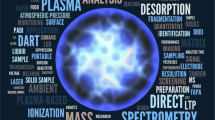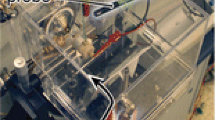Abstract
The introduction of ambient ionization at atmospheric pressure for mass spectrometry (AI-MS) attracted the interest of many researchers in the field and various ionization techniques have been described in recent years that allow a quick and easy-to-handle analysis of samples under ambient conditions without or with only minor sample preparation. Among those, plasma-based techniques including the low-temperature plasma probe require very little resources thereby providing great potential for implementation in mobile analytical devices. However, systematic studies on signal responsiveness with this technique, such as the influence of the analyte and matrix characteristics on relative signal intensity, are still rare. Therefore, we used a low-temperature plasma source based on dielectric barrier discharge with helium as process gas to assess influencing factors on signal intensity in mass spectrometry. Among 12 tested molecular descriptors, in particular a low vaporization enthalpy and a large molecular nonpolar surface area improve the relative signal intensity. In addition, we show that the impact of compound characteristics strongly outperforms the influence of simple sample matrices such as different organic solvents and water, with a weak trend that volatile solvents tend to decrease the signal responsiveness of the analytes. However, several specific solvent-analyte interactions occurred, which have to be considered in targeted applications of this method. Our results will help further in improving the implementation and standardization of low-temperature plasma ionization for ambient mass spectrometry and understanding the requirements and selectivity of this technique.

Influencing factors (analyte and matrix characteristics) on signal intensity in dielectric-barrier discharge plasma for ionization in mass spectrometry.




Similar content being viewed by others
References
Takats Z, Wiseman JM, Gologan B, Cooks RG. Mass spectrometry sampling under ambient conditions with desorption electrospray ionization. Science. 2004;306:471–3.
Chen H, Venter A, Cooks RG. Extractive electrospray ionization for direct analysis of undiluted urine, milk and other complex mixtures without sample preparation. Chem Commun (Cambridge, UK). 2006:2042–4.
Haddad R, Sparrapan R, Kotiaho T, Eberlin MN. Easy ambient sonic-spray ionization-membrane interface mass spectrometry for direct analysis of solution constituents. Anal Chem. 2008;80:898–903.
Shiea J, Huang M-Z, Hsu H-J, Lee C-Y, Yuan C-H, Beech I, et al. Electrospray-assisted laser desorption/ionization mass spectrometry for direct ambient analysis of solids. Rapid Commun Mass Spectrom. 2005;19:3701–4.
Sampson JS, Hawkridge AM, Muddiman DC. Generation and detection of multiply-charged peptides and proteins by matrix-assisted laser desorption electrospray ionization (MALDESI) Fourier transform ion cyclotron resonance mass spectrometry. J Am Soc Mass Spectrom. 2006;17:1712–6.
Nemes P, Vertes A. Laser ablation electrospray ionization for atmospheric pressure, in vivo, and imaging mass spectrometry. Anal Chem. 2007;79:8098–106.
Cody RB, Laramée JA, Durst HD. Versatile new ion source for the analysis of materials in open air under ambient conditions. Anal Chem. 2005;77:2297–302.
Ratcliffe LV, Rutten FJM, Barrett DA, Whitmore T, Seymour D, Greenwood C, et al. Surface analysis under ambient conditions using plasma-assisted desorption/ionization mass spectrometry. Anal Chem. 2007;79:6094–101.
Harper JD, Charipar NA, Mulligan CC, Zhang X, Cooks RG, Ouyang Z. Low-temperature plasma probe for ambient desorption ionization. Anal Chem. 2008;80:9097–104.
Venter A, Sojka PE, Cooks RG. Droplet dynamics and ionization mechanisms in desorption electrospray ionization mass spectrometry. Anal Chem. 2006;78:8549–55.
Na N, Zhao M, Zhang S, Yang C, Zhang X. Development of a dielectric barrier discharge ion source for ambient mass spectrometry. J Am Soc Mass Spectrom. 2007;18:1859–62.
Andrade FJ, Wetzel WC, Chan GC-Y, Webb MR, Gamez G, Ray SJ, et al. A new, versatile, direct-current helium atmospheric-pressure glow discharge. J Anal At Spectrom. 2006;21:1175–84.
Andrade FJ, Shelley JT, Wetzel WC, Webb MR, Gamez G, Ray SJ, et al. Atmospheric pressure chemical ionization source. 2. Desorption-ionization for the direct analysis of solid compounds. Anal Chem. 2008;80:2654–63.
Harris GA, Galhena AS, Fernández FM. Ambient sampling/ionization mass spectrometry: applications and current trends. Anal Chem. 2011;83:4508–38.
Weston DJ. Ambient ionization mass spectrometry: current understanding of mechanistic theory; analytical performance and application areas. Analyst. 2010;135:661–8.
Albert A, Shelley JT, Engelhard C. Plasma-based ambient desorption/ionization mass spectrometry: state-of-the-art in qualitative and quantitative analysis. Anal Bioanal Chem. 2014;406:6111–27.
Hayen H, Michels A, Franzke J. Dielectric barrier discharge ionization for liquid chromatography/mass spectrometry. Anal Chem. 2009;81:10239–45.
Kogelschatz U. Dielectric-barrier discharges: their history, discharge physics, and industrial applications. Plasma Chem Plasma Process. 2003;23:1–46.
Kiontke A, Holzer F, Belder D, Birkemeyer C. Requirements of low-temperature plasma ionization support miniaturization of the ion source. Anal Bioanal Chem. 2018; https://doi.org/10.1007/s00216-018-1033-7 .
Newsome GA, Ackerman LK, Johnson KJ. J Am Soc Mass Spectrom. 2016;27:135–43.
Song L, Gibson SC, Bhandari D, Cook KD, Bartmess JE. Ionization mechanism of positive-ion direct analysis in real time: a transient microenvironment concept. Anal Chem. 2009;81:10080–8.
Na N, Xia Y, Zhu Z, Zhang X, Cooks RG. Birch reduction of benzene in a low-temperature plasma. Angew Chem Int Ed Engl. 2009;48:2017–9.
Kiontke A, Oliveira-Birkmeier A, Opitz A, Birkemeyer C. Electrospray ionization efficiency is dependent on different molecular descriptors with respect to solvent pH and instrumental configuration. PLoS One. 2016;11:e0167502.
Evans JD. Straightforward statistics for the behavioral sciences. Pacific Grove: Brooks/Cole Publishing Company; 1996.
Huang G, Xu W, Visbal-Onufrak MA, Ouyang Z, Cooks RG. Direct analysis of melamine in complex matrices using a handheld mass spectrometer. Analyst. 2010;135:705–11.
Garcia-Reyes JF, Harper JD, Salazar GA, Charipar NA, Ouyang Z, Cooks RG. Detection of explosives and related compounds by low-temperature plasma ambient ionization mass spectrometry. Anal Chem. 2011;83:1084–92.
Lee HJ, Oh J-S, Heo SW, Moon JH, J-h K, Park SG, et al. Peltier heating-assisted low temperature plasma ionization for ambient mass spectrometry. Mass Spectrom Lett. 2015;6:71–4.
Wiley JS, Garcia-Reyes JF, Harper JD, Charipar NA, Ouyang Z, Cooks RG. Screening of agrochemicals in foodstuffs using low-temperature plasma (LTP) ambient ionization mass spectrometry. Analyst. 2010;135:971–9.
Albert A, Engelhard C. Characteristics of low-temperature plasma ionization for ambient mass spectrometry compared to electrospray ionization and atmospheric pressure chemical ionization. Anal Chem. 2012;84:10657–64.
Keeney M, Heicklen J. Surface tension and the heat of vaporization: a simple empirical correlation. J Inorg Nucl Chem. 1979:1755–8.
Viswanath DS, Kuloor NR. Latent heat of vaporization, surface tension, and temperature. J Chem Eng Data. 1966;11:69–72.
Petucci C, Diffendal J, Kaufman D, Mekonnen B, Terefenko G, Musselman B. Direct analysis in real time for reaction monitoring in drug discovery. Anal Chem. 2007;79:5064–70.
Shelley JT, Hieftje GM. Ionization matrix effects in plasma-based ambient mass spectrometry sources. J Anal At Spectrom. 2010;25:345–50.
Szatyłowicz H. H-bonded complexes of aniline, phenol and pyridine derivatives. J Phys Org Chem. 2008;21:897–914.
Rappoport Z. The chemistry of anilines. Part 1. Chichester: Wiley; 2007.
Acknowledgements
The authors thank Dr. ing. Susan Billig, Ramona Oehme, Josef J. Heiland, Sebastian Piendl, Harald Knorke (all University of Leipzig, Germany) and Aigerim Galyamova (Penn State University, USA) for technical assistance. In addition, we thank Prof. em. Berger (University of Leipzig, Germany) for kind and constant support.
Funding
This work was financed by the Deutsche Bundesstiftung Umwelt (DBU grant No. 20015/375), the German Academic Exchange Service (DAAD “Rise” program 2016), and the University of Leipzig.
Author information
Authors and Affiliations
Corresponding authors
Ethics declarations
Conflict of interest
The authors declare that they have no conflict of interest.
Electronic supplementary material
ESM 1
(PDF 929 kb)
Rights and permissions
About this article
Cite this article
Kiontke, A., Engel, C., Belder, D. et al. Analyte and matrix evaporability – key players of low-temperature plasma ionization for ambient mass spectrometry. Anal Bioanal Chem 410, 5123–5130 (2018). https://doi.org/10.1007/s00216-018-1152-1
Received:
Revised:
Accepted:
Published:
Issue Date:
DOI: https://doi.org/10.1007/s00216-018-1152-1




